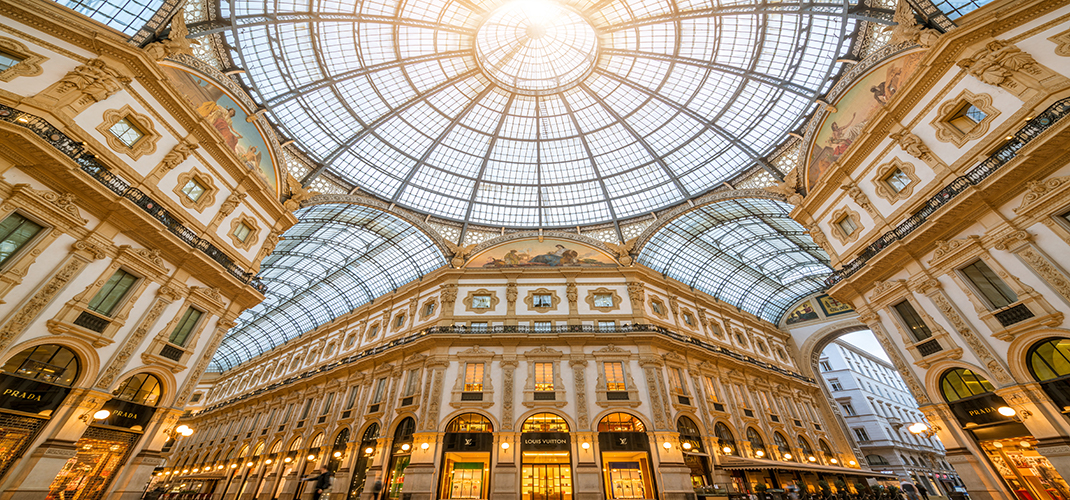Milan

Milano (Milan) has been home to some of the most famous artists in the world including Leonardo da Vinci and Michelangelo, composers like Verdi and the great tenor Enrico Caruso and designers like Giorgio Armani. It has a rich history including, where Napoleon crowned himself inside the famous Duomo and where St. Augustine was baptised in a Basilica that stood at what is now Piazza del Duomo and lastly it is also where Mussolini founded the Fascist party. Milan is a city not to be missed when coming to Italy as it has so much to offer.
At the heart of Milan is the massive Milan Cathedral of Santa Maria Nascente, locally called ‘Il Duomo’, one of the world's largest and most beautiful Gothic Churches. Construction began in the 14th Century, however its façade was not completed until the early 1800's. The roof is topped by 135 meticulously carved stone pinnacles and the exterior is decorated with 2,245 marble statues. The striking interior has 52 gigantic pillars, beautiful stained glass windows that teem with colour and various artworks. Highlights include the seven branched bronze candelabrum by Nicholas of Verdun (c. 1200), the 16th Century Tomb of Gian Giacomo Medici and the jewelled gold reliquary of San Carlo Borromeo in the octagonal Borromeo Chapel leading off the crypt. A walk on the Cathedral roof, offers views over the city and extending on a clear day to the snow covered Alps.
The Piazza del Duomo is an enormous open public space that features some impressive architecture and sculptures. At the centre of the square stands a glorious statue of the first King of the united Italy, Vittorio Emmanuel, whilst on one side sits the impressive Royal Palace. You will also find there are a lot of luxury shops, restaurants and bars to visit.
Close to the Piazza del Duomo you will find the Santa Maria Presso San Satiro, a small and unassuming Church on a nearby shopping street, however once inside you will be pleasantly surprised with is grand and majestic vaulted sanctuary, stretching into an apse that's nearly the length of the entire main portion of the Church.
The Castello Sforzesco is a 15th Century Castle set in extensive grounds and gardens. The Castle was kept by the Visconti and the Sforza families who once ruled Milan between 1277-1447 and also between 1450-1535. The Castle was built in 1368 and later rebuilt in 1450. The Castello houses the Musei del Castello Sforzesco, museums, one of which features sculptures. The collection includes the Pietà Rondanini, Michelangelo's last masterpiece, brought here in 1953 from the Palazzo Rondanini in Rome.
The Santa Maria delle Grazie is a red brick Gothic Church, located on the Corso Magenta. Work began around 1465 and its massive six sided dome is the finest Early Renaissance style designed by Bramante, one of Italy's most influential Renaissance architects. The interior of the Church houses one of the greatest masterpieces in the world ‘The Last Supper by Leonardo di Vinci’. Acknowledged as a sublime piece of artwork, this mural depicts the scene of the Last Supper as described in the Bible.
Forming one side of Piazza del Duomo through to the Piazza della Scala on the other side, is the grand Galleria Vittorio Emanuele II. Designed by Giuseppe Mengoni it was constructed between 1865-1877 and stands as one of the oldest shopping arcades in the world. This cross shaped shopping arcade is covered with four glass panelled arms that lets the sunlight in perfectly, with a dome soaring 48 metres above its mosaic floor. Today this vibrant centre is where people meet for lunch or coffee and shop the luxury high end designers like Prada, Versace and Luis Vuitton.
The Teatro alla Scala Opera House is classified as one of the most prestigious in the world and is renowned for its acoustic qualities and opulence. Inside the main auditorium the decoration and grandeur of the seating and stage is amazing with six tiers of seating and individual boxes that frame the stage in a semicircle, the entire theatre is full of red velvet drapes and gold furnishings.
Museums to visit while in Milan include the Museo Nazionale Scienza e Tecnologia Leonardo da Vinci where you will find collections of his drawings, blueprints and sketches as well as model cars and reconstructions of his flying machines, breakthrough technology that changed the world. The Civica Galleria d'Arte Moderna (Modern Art Gallery) houses Italian art, from the 19th Century Romanticism to post-impressionists, with collections by Renoir, Picasso and Matisse to name a few. Cimitero Monumentale with its magnificent architecture and art from the Ancient Greek, Roman, medieval and Renaissance eras is an outdoor gallery of Art Nouveau sculptures. Behind a monumental and flamboyant striped marble portico, these monuments mark the tombs of Milan's rich and famous from the late 1800's through to the mid-20th Century. The 19th Century Poldi-Pezzoli Museum is an elegant old patrician house that houses a private collection the highlight being the paintings by Botticelli, Mantegna, Piero della Francesca and Guardí.
The delightful Brera district is located north of the Duomo. It has a distinctive Bohemian atmosphere and the district is full of art academies, galleries and upmarket restaurants and bars. Here the vibe is electric, where you can enjoy a fine meal or do some retail therapy by walking down its many cobbled streets.
Churches to visit while in Milan include the Romanesque Basilica of Sant'Eustorgio built between the 12th-13th Centuries with frescoes by Vincenzo Foppa. The Church of Sant'Ambrogio was founded in 386 by St. Ambrose, who is the city's Patron Saint. The Church of San Maurizio is one of the most beautiful in Milan. Built in the early 1500’s as the Church for a convent of Benedictine nuns, the entire interior is covered in frescoes of biblical scenes.
